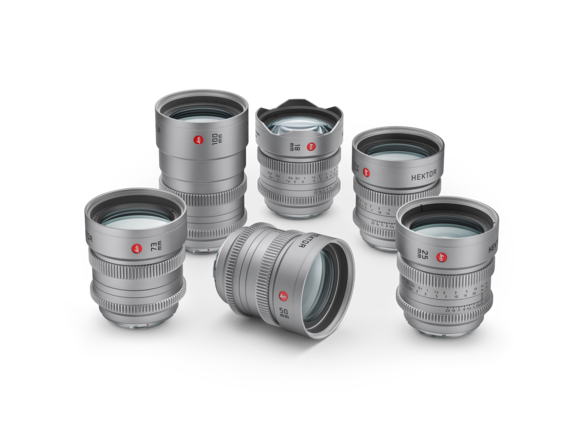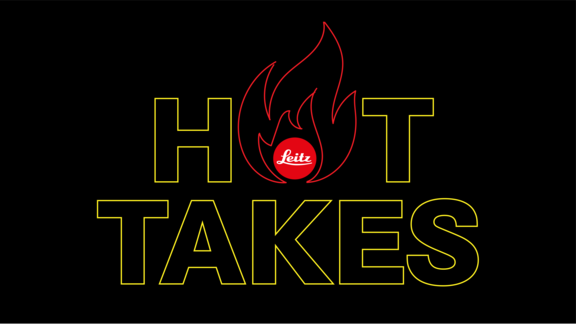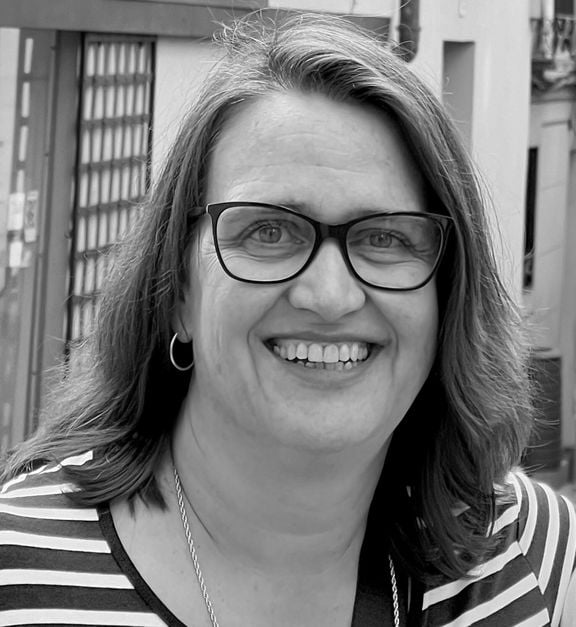MARCH 18, 2021
Jon Fauer - FDTimes, March 2021
Matty Libatique, ASC uses lenses the way a sommelier pairs wine glasses to balance the look and taste of various vintages and help “tell the story” of a memorable meal.
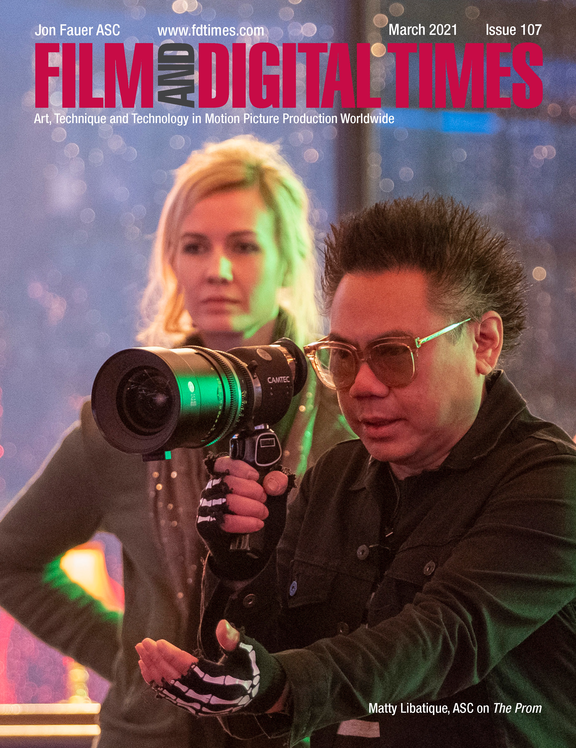
Matty seems to revel in trying out different lenses and different brands.
This discussion revolves around his recent work on The Prom.
Filming began around the end of November 2019.
But like the many different lenses and cameras he uses, this story is not just about working on The Prom, directed by Ryan Murphy, with Meryl Streep, Nicole Kidman, Kerry Washington, James Corden and company.
Matty takes us on a journey of lenses, cameras, lighting, the future of the industry, early days as Ed Lachman’s assistant, cinematography for Zoom meetings, and more.
Jon Fauer: Your lighting is really good on this Zoom session. You deserve an ASC award for best Zoom cinematography.
Matty Libatique: I have had plenty of time to work on it.
Good single source sidelight, nice background focus fall-off, rich contrast and color.
I’m using a Fujifilm X-T3 connected to an Elgato 4K Cam Link. It converts HDMI to USB that goes into the computer. I’m not messing around.
A DMG Lumiere SL1 on the camera right side?
No, that’s a window. Available light. That’s why I only do day calls.
Haha. Next question: are you mostly shooting Full Frame or Super35 lately?
Mostly Full Frame. The Prom was on ALEXA Mini LF, as was Don’t Worry Darling, the film I just wrapped. It’s interesting, there are two worlds in Full Frame.
Panavision has such a large library of glass, and a lens team led by the great Dan Sasaki, that you can actually take what they have, be inspired by it, change it, tweak it, pull minimum focus closer, or put minimum focus farther away. You can do things to create your own look. And serve the Large Format.
The PL and LPL world is a different situation. The PL mount Super35 world consists of a vast inventory of glass that already exists. Many people are getting in the game of tweaking those PL lenses. It’s more of a wild, wild West; it’s a free-for-all about what covers and what doesn’t and what satisfies the artistry. I’ve had conversations with Ed Lachman, ASC recently about this. We stay in touch. He’s a mentor and a friend and I was his assistant. He’s looking forward to being able to get the new Super35 4K camera from ARRI when it comes out, maybe next year, and then use lenses that he liked so much in the past: Cooke Panchros, for example, maybe even Lomo, and have so many options available.
That is a reason I have a love-hate relationship with Large Format right now. I do not have a favorite lens set. I do not have a favorite glass. I need as many choices as possible going into a film because the film dictates the glass to me. It’s not the other way around. It’s not because of the technology that I choose a lens; I respond to the lens because of what it brings to the aesthetic.
Nicely explained. But do you agree that we have recently seen the arrival of many new Full Frame lenses? Don’t they offer you more choices than maybe a year ago?
Absolutely. I’m using a set of Tokinas that cover Full Frame right now. The latest Leitz Prime set is fantastic and I used those on The Prom. The Canon K35 primes, of course, saturated the market in terms of their use. I know there are ZEISS Supreme and Radiance sets that cover Full Frame. Recently, I used some Falcons, developed by Kavon Elhami and Camtec. They ended up covering about 85% of the ALEXA 65 sensor, and they cover the full sensor of the ALEXA Mini LF.
During the Covid lockdown, Blackmagic lent me one of their Pocket Cinema 6K cameras. I was doing drills, as in, how many setups can I get done in a day all by myself. It was like an exercise: can I do six shots right now? What six shots? How fast can I do them? Can I change filters? I was thinking: could this be the future for me? I had no idea.
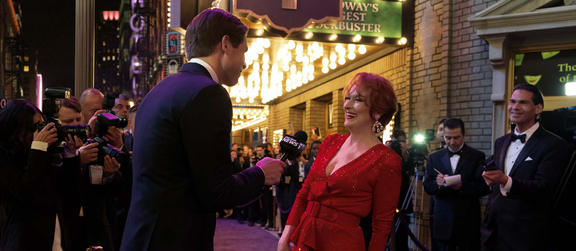
What camera and lenses did you use on The Prom?
The camera was an ARRI ALEXA Mini LF. I think this was the first feature where I used the Mini LF. The lenses were Full Frame Leitz Primes, Camtec Falcons and Tribe7 Blackwing7 Primes. Also Angenieux EZ Zooms.
How did you get the Leitz Prime set? The Prom was last year and Leitz Primes must have just come out, still with wet paint?
The way I got them is an oddly full-circle story. I did the short film Wake Up with Olivia Wilde in the fall of 2019. Rainer Hercher at Leitz was able to provide a test set. The combination of Leitz Primes and Sony VENICE was fantastic, especially in low light. I liked the way they opened up; they were fast. I was dealing with disparate levels of light from windows that I couldn’t control and I was moving very quickly. I liked how the Leitz Primes handled highlights. In that short, I also mixed Blackwing7s. I wanted to see whether I could mix them together.
Typically, I haven’t used just one set of lenses on a film in six years; I’ve mixed them. To me, every situation requires different tools. I learned that from Ed Lachman. I have to say that I never understood why you would painstakingly pick a lens set and then find yourself in a situation where that set wasn’t actually performing the way you wanted it to.
Working for Ed Lachman as an assistant involved lots of running. He’d call for a lens set that was still in the truck. “We should get the K35 Primes,” he’d say. So I’d run. And soon after: “Are my Panchros on the truck?” I’d reply, “Yes, your Panchros are on the truck.” And then I had to run to get them. There would be one hero lens set that everybody thought we were shooting the movie with, but then Ed kept switching lenses. I learned that from him. There’s no way I have to adhere to the so-called tradition of having to stick with one set of lenses for the whole movie.
On The Prom, and in general, do you have a lens plan when you’re prepping? As in: this scene is with this lens, that next scene is with that one, depending on mood, scene or script?
Sometimes it’s predetermined. I go in with a plan of knowing how I want to shoot. For example, on The Prom I wanted the world of these narcissistic Broadway actors to be associated with the Leitz Prime look: glitzy, glamorous, expensive. But I wanted aberrations when it came to the Indiana scenes; I wanted it to be a little raw, to feel more realistic. It’s hard to do. Sometimes, depending on the situation in the Indiana scenes, I would use the Falcons, but in some of the more theatrical scenes, I would use the Blackwing7s because I wanted to take advantage of what they did. That was the planned combination.
And then, when it actually came to shooting, I would improvise based on things that worked and didn’t work. So, it’s a combination of putting a plan together and then as time goes on, augmenting that plan based on what works or doesn’t work.
The opening number in front of the Broadway theater was with Leitz Primes?
Yes, the Broadway scene was with Leitz Primes. Their color rendition is great. Then towards the end of the movie, as things come together, it transitions back to those lenses. If you look at the last scene of The Prom, there are very few lens aberrations. It becomes clean again; it’s getting back to a stylized look. It’s like a celebration. I wanted the film to start somewhere. I wanted to transition to another place and then I wanted to have it all combined in the end.
The camera moves were excellent.
There was a lot of Steadicam; Ryan loves Steadicam. We had two great operators: Scott Sakamoto and Andrew Mitchell (who did most of the Steadicam.) Matt Stenerson was our First AC.
Was the opening night Broadway exterior shot on location?
The exterior was shot on a makeshift backlot in Downtown LA where our production designer Jamie Walker McCall built an amazing exterior one-block replica of 44th street.
And then you’re night, interior, Sardi’s.
Looking out the Sardi’s windows, we see the Schubert Theater.
You can probably tell it’s not New York because the real Schubert is offset from Sardi’s and we have them literally across the street from each other. This was all entirely built on stage at Paramount.
Ryan Murphy, our director, wanted to have a very old, tungstenlit feel, so we had a lot of tungsten lights. There’s very little LED. There are LEDs in some of the posters, behind the posters and things that we could hide. But the rest of the scene was all lit with tungsten fixtures.
The sign outside the window is real. They built the front of the Schubert Theater for the exterior. The Schubert marquee was dismantled and rebuilt back on stage after we finished doing the exteriors. Some of the light was motivated by the Sardi’s sign. Anyone familiar with being at Sardi’s knows the feeling of seeing that green neon and I just wanted to call it out.
Meryl Streep and James Corden as Barry Glickman in Sardi’s scene.
You can see the soffit in the ceiling. There are several runs of LightGear LiteRibbon RGB LEDs up there. My programmer’s name is Scott Barnes; we’ve worked together forever. The color palette was magenta, aqua, cyan and a kind of purple. I gave him some guidelines along with the music; that’s most important. What you see is largely a few fixtures hung on the side of the chandelier to create a pool of light in the center, but everything else was coming from the bounce off the ceiling.
Outside the window, there are movers. I had to use very hard light and expose it accordingly because I had water dripping down those windows. I wanted to see if I could create shadows on the faces. You can see it on Andrew Rannells in the waiter jacket. So a lot of what you see in that haze is really just an errant mover. That’s creating hard light, it’s backlighting Nicole in the foreground.
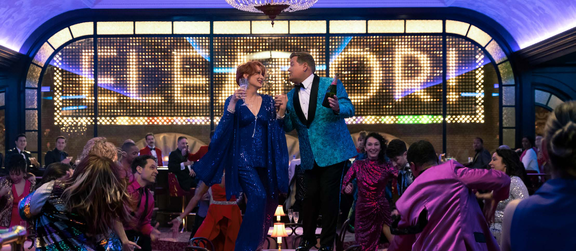
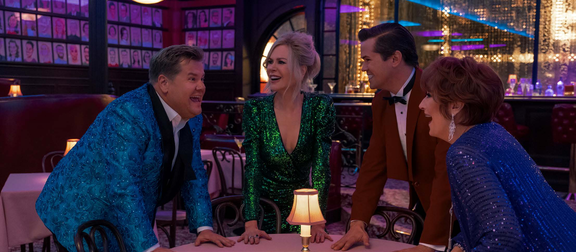
Were you using real neon or LED?
That’s a good question. Whatever was neon was real neon. It would have been more expensive to actually use LED ribbons and have them shaped. I remember it definitely was neon because I had no control over it.
Again, there’s rain and the presence of green light. I matched the Sardi’s sign just to make sure that I had the light in the right place. I was using a portion of the ceiling ring. Soon after this, Barry started to sing and we moved into another performance. I had to build in lighting that was going to accommodate that. I was trying to play the faces in a place that seemed natural in terms of exposure and level, but still see the people and then have the capability to be able to not get caught because soon after this, I was moving the camera around the entire space again, and then Barry started to sing his next number.
Was that Sardi’s number a Steadicam move?
It was a combination of Steadicam and a little bit of jib arm work. The previous number, outside the theater, was a combination of MovieBird crane and Steadicam.
The colors and skin tones were terrific.
Yes. The soft fall off, the color rendition. Here’s the thing I learned: water on the window. How could I do that scene without having to justify water on a window? I love the way that window looks.
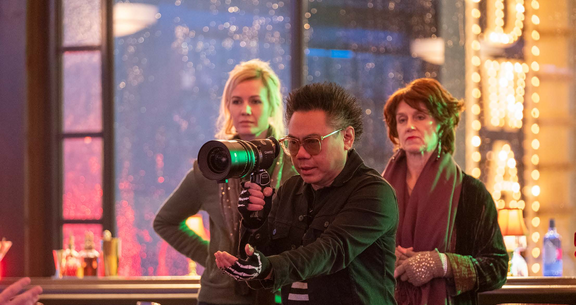
Did you use any diffusion?
I was using a device that Camtec developed called the Color-Con. I contributed to the design.
Do you remember the Lightflex, Panaflasher and Varicon? Then imagine, instead of the entire thing being a large piece of glass in front with a hot light at the top, it’s a filter tray that fits in either a 4x5 or 6x6 mattebox. It is controlled via DMX by a wireless system that Camtec developed. More than a hundred RGB LED emitters surround the filter in the filter tray. And you can isolate left, right top and bottom. Originally it was basically a reaction to what I tried to do on Straight Outta Compton, where I was trying to flare the lens. It never worked that way because the emitters were too close to the glass.
The Color-Con requires a filter with a texture that the LEDs can catch. You place the diffusion filter of your choice into the filter tray, and then you can bring up a percentage of light to flash the shadows.
I used a Tiffen Glimmerglass as the base filter inside the Color- Con. Depending on focal length, I used a 1/4 or 1⁄2 Glimmerglass. You have to learn how to use it. If you’re not getting quite the effect, then you know you’re pumping the LED intensity up too high. Sometimes I would put a heavier filter inside. If I wanted to be more subtle, I would go with the lower grade Glimmerglass.
In the Indiana scenes, I guess the lenses were Blackwing7 Primes? Windows and highlights seemed to go hazy.
It was a combination of Blackwing7s and Camtec Falcons in the school. Oddly for me, the hazy flare was one of my favorite qualities, but also what I think might sometimes limit the set for me. You know how it is. We’re making movies for people, but we’re also making movies for our peers. And every time you see that distinctive stamp everybody knows what you’re doing. It worked for the particular scenes, the school, for example. This is where I feel they worked best.
Were these the original Blackwing7s?
Yes. It was literally Set 001 that was delivered to Kavon Elhami at Camtec.
I had the whole set: 27, 37, 47, 57, 77, 107 and 137.
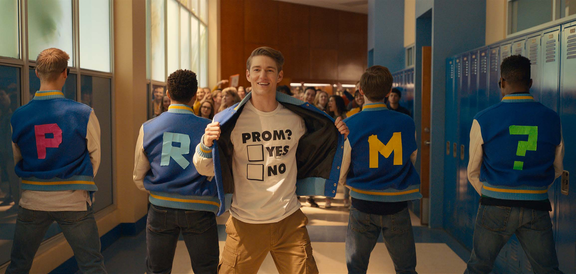
And the Leitz primes?
I had the 18, 21, 25, 29, 35, 40, 50, 75 and 100 mm.
The scene with Nicole Kidman and Jo Ellen Pellman in her home didn’t flare as much.
I used the Leitz Primes and Angenieux Full Frame EZ Zooms.
Really? What was the reason for working with EZ Zooms?
On the Steadicam, we would sneak focal length changes as we went along. The sequence was in the house set. I remember it being difficult to be wide enough and tight enough. I had a lot of fun with those lenses: the Angenieux EZ-1 45-135 T3 and the EZ-2 22-60 T3. They created something that’s very useful for mobile cameras. I often do a lot of Ronin and MoVi gimbal shots. In this film, we had a lot of Steadicam and those zooms have become invaluable. Just having the quality of glass that they’ve been able to create is good. It’s about, “Can I fit this glass into the language of the look I’m using for the film and not have it bump.” It’s been a nice addition when I’ve needed a zoom.
Did you plan in advance what lenses you were going to use in this scene?
In this case it was a matter of focal length. For example, if we’re doing almost the entire performance in a moving master, where one focal length cannot accommodate the entire scene, then I would use the Angenieux EZ zoom.
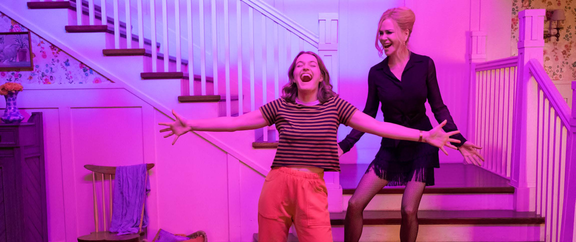
Did you decide that on the spot, at the moment?
Yes. Because when I’m prepping I really don’t get a sense of how big the set is.
What light fixture was blasting through the window?
That was an ARRI L10 LED (10" Fresnel, 510 W), and SkyPanels above a soft ceiling in the set at Raleigh Studios Hollywood.
What about the mall scenes?
This is another case where it was a combination of Camtec Falcons, Blackwing7s and the Angenieux EZ zoom, depending on the shot. The low mode Steadicam shot was done with a 20mm Falcon with mostly natural light. We had some fixtures up in the skylight. It was just horrifying. There are few things more banal than mall lighting. It was a real mall. It was open. We were dealing with people in the background and we didn’t have a lot of options.
But it’s a great number.
Another scene with a great camera move was in her bedroom.
Ryan and I talked about what we could do with this scene. We ended up laying track, put wheels under the bed and pulled it away from the wall. Two grips started spinning her around in the middle of the room.
The whole time it was about how we would we handle each number? Where are we in the film? What is the progression of things. At this point it was about her making the big decision and communicating to the world who she was. We wanted to have a sense of Broadway, so this is what we came up with. This was actually the Angenieux EZ-1 zoom again.
I was going to guess it was a Blackwing7.
That’s a 20K hitting the lens and I was shooting it as wide open as I could as well, so all those glass elements were contributing to that flare. We used four SolaFrame 3000s by High End Systems, as well, for more spread in the small space. The previous version of those lights wouldn’t have been able to spread out as much.
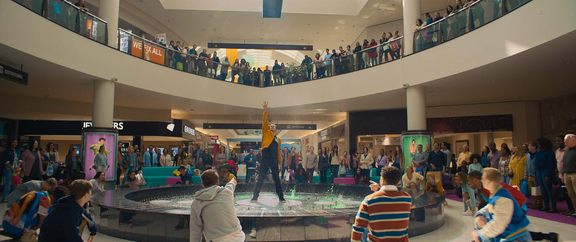
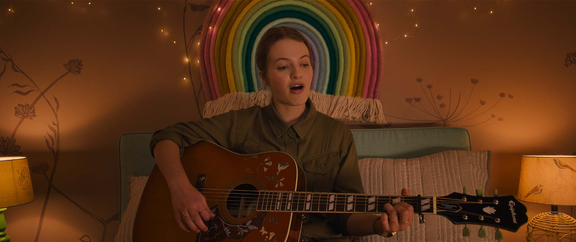
Please talk about the big studio number at the end.
A lot of it was shot with the Leitz Primes. We were using so much color. The trick was trying to not lose the faces in the color. So, augmenting it with white light helped. I’m a big fan of adjusting the color temperature of the camera to find the right balance. If you look at our camera reports in the data books that we kept, you’ll see color temperatures change constantly.
When I know there are going to be a lot of different colors, first I try to evaluate the white point of the lighting units. Then I try to consider how much I need it to be in one direction. Typically, at the beginning of the scene, the camera assistant will ask, “Where do you want to set it?” I’ll say 4500 K. Sometimes I do 4,000 if I don’t want it to be as warm. Maybe I do it at 3,500, and then 5,500. It’s really about considering how much disparity I want between the colors.
Did you have to compensate for the different lenses in grading?
I had to adjust a little bit for some of the lenses. The Camtec Falcons were different than the Leitz Primes for sure, but I didn’t mix those. But I noticed about 500 degrees of Kelvin difference between them. These are subtle differences, and I just know how to deal with them.
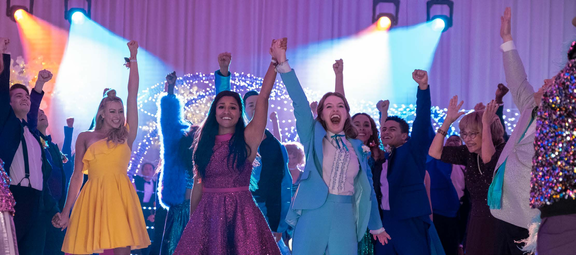
Are the Leitz Primes cooler than Blackwing7s?
The Blackwings are certainly warmer. Especially when they get hit with a light and flare. The Camtec Falcons flare out broadly. I remember with early Cooke S4 lenses, we had to flag them a lot to avoid too much flare. They reacted differently.
For example, if you were on a show using Panavision Primos and then you had an S4 set, the S4 would take the light and spread it over the image a little more. So that’s what the Falcons remind me of.
What was great about the Leitz Primes was that I could include a window and make it look really natural, even if it was an artificial setting. What I learned, when I shot with them the first time, was how they would look even when I couldn’t control the exterior light and perhaps it might not have been the right time of day. Maybe I didn’t have quite enough light on the interior. How were they going to handle that? And so I put the Leitz Primes through their paces and they allowed me to light in such a way where I could blow out the windows and make it look almost...accidental.
Did you use any tungsten lighting aside from the opening Broadway sequence?
I used almost all LEDs. The only tungsten I used were the 20Ks outside a window. Sometimes I’d set the camera at 4000 or 4500 color temperature and use the 20Ks as sunlight. Typically, the 20K lights are 3200 to 2800 color temperature. I’ll use them as a sun and sometimes I’ll use them in day exterior and let them be warm.
How much time did you spend on grading?
We were grading during COVID times. I was prepping Don’t Worry, Darling at that time—around October 2020. It took about three to four weeks of grading, just because my time was limited and Steve Scott was also doing two things at once and also because we were remote. He was at home. I went to Company 3 in Hollywood and were dealing with each other on speaker phone.
You graded remotely from home?
No, I went to Company 3 in Hollywood to watch on a calibrated monitor. Steve Scott had a remote Lustre setup at home.
Getting back to the camera. Did you set up any LUTS?
Well, that’s interesting. I did set up a LUT with Steve Scott. I liked the LUT that we created on Birds of Prey. I liked the look, the saturation, but when I analyzed it against previous LUTS that I used, they required so much light. So I shot some footage and did over and under exposures, just like an old-school film test. I brought these to Steve and asked him to re-rate the underexposure a stop higher, apply the LUT and then tweak that shot to match the LUT of the normal exposure. And then that was our LUT. I basically made the same LUT more sensitive by cheating it. Then I applied it and got back to the light levels that the camera would actually have required if I didn’t use a heavy LUT.
And how did you rate the ALEXA Mini LF? What ISO?
ISO 1280 most of the time. I’d switch to 800 every once in a while.
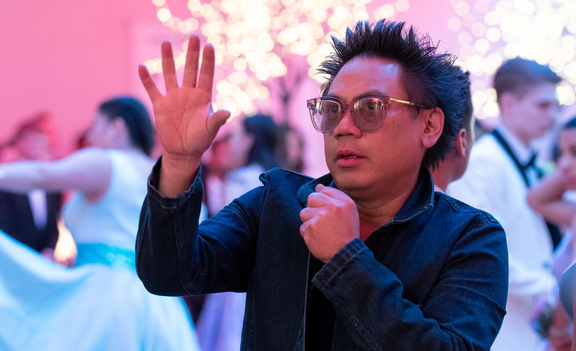
The opening night exterior was at ISO 1280?
Yes. That being said, there was a lot of tungsten going on there, and a lot of the augmentation was at the end of the street. I had 360s quad split to different colors. I had them aim from one area to another so that there would be a little augmentation of color and a bit of life in the shadow areas.
Did you shoot Open Gate ARRIRAW?
Yes. I had done three straight anamorphic films. For The Prom, Ryan loved the idea of shooting in widescreen 2.39:1. But I just didn’t want to shoot anamorphic again; I was tired of it. And the other thing was that there were so many people in the shot—it would have framed nicely, but I didn’t want to be in a place where all of a sudden I had to choose focus between them. I’ve grown weary of people shooting shallow depth of field when there are four people in the scene and you don’t know whom to see. There’s a responsibility. I don’t want people to think about focus when
you’re supposed to look at the entire group. That was one of the first decisions I made: to go spherical 2.39:1 instead of anamorphic.
In the days ahead, will movie theaters still be relevant or will streaming be all that’s left?
I equate theaters with restaurants. Obviously, many people miss restaurants, but they also miss theaters. I do think theaters will be viable in the future, but I don’t know whether they will have the same business model as before. There might be less of an expectation from them and it might be a little more symbolic in terms of what the box office means.
Perhaps movie theaters will be more like Broadway venues, a special event or a chance to go out.
So many things have happened. There’s no putting streaming back into Pandora’s box. I’m not a business person, but I can imagine that theatrical runs will be shorter. Marketing is going to pivot promotion of films to make them events.
I also think that Netflix, HBO, Amazon and Apple will work towards theatrical runs in the name of cinema. Because they are tech companies from Silicon Valley, they have the power and the resources to be able to pull it off. That would go a long way toward appeasing the artists they want to be in business with and making them feel like the business cares about them. It could be a rebirth of a business that’s been beholden to the studio system for so long. If it were the other way around and we were relying on Universal, Warner Brothers and others, I don’t know if theaters would be viable, but ironically, the streamers are the ones who might help.
The word Camtec jumps out on cover of this edition. Matty Libatique is holding a Leitz Prime in a finder I had never seen before. To follow up about the finder and the Camtec Color-Con that Matty also mentions in his interview, Kavon Elhami, President of Camtec, explains:
Camtec Finder on Cover
When Matty started on The Prom, I was evaluating a Full Frame finder from Zero Optik at the time. I showed it to Matty and he liked it. I asked Alex Nelson, Founder and Owner of Zero Optik, if Matty could hang on to it, and he agreed.
Camtec Color-Con
We were working on a variable color contrast device at Camtec a couple of years ago and showed it to Matty. It still had wires dangling all over the place. He was immediately drawn to it and made valuable suggestions on the design.
Color-Con works as a filter tray into which you put an effect filter. RGB LED lights surround the filter along the edges on all four sides. The concept is to put any diffusion, fog or effect filter you like in the tray—anything for the light to bind onto. It works especially well with white speckles. For the first version, the whole assembly was one light, so you either adjusted intensity or color as a whole. Matty used that version often on Venom and A Star is Born. After that, he said, “It would be really cool if I could control each one of those LED pixels individually.”
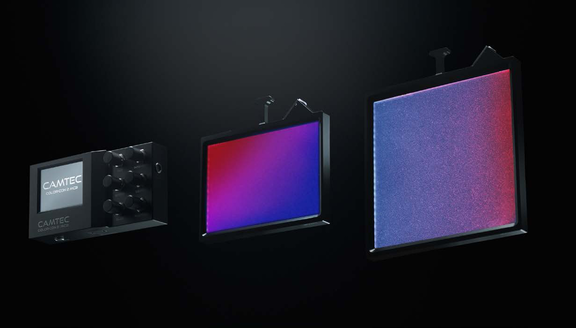
Color-Con 2
So, with that in mind, we started working on the Color-Con 2. It is interesting because you can control each pixel individually. Matty’s team helped to find a way to control it. And then we went ahead building a unit as a custom, wireless way of controlling the Color-Con 2. Basically, his DMX operator dials in the parameters. We have 4x5 and 6.6x6.6 versions. The 6x6 tray has about a hundred LEDs all the way around. He can control each one of those LEDs as if it’s a separate light on set, for example, in a concert or musical number.
Since then, we’ve made a simplified manual control box (see photo above), and that is a way for other people to get used to the Color- Con that is not as complicated. It is well-suited for commercials. On both versions, you can select the individual LEDs, or you run them as a chase-light sequence, or you can grow and shrink the effect. You can have a little blue from one side and a little red from the other side. The wireless version is geared to features films where you have a DMX board technician programming it into the overall lighting system.
Color-Con Filters
Matty has been using Tiffen Glimmerglass the most. Because he’s using a few different Glimmerglass strengths, we outfitted him with multiple trays that have these filters already built in so he can quickly change them on set. In addition to Glimmerglass, we also like Color-Con with Tiffen White Pro-Mist, Fog and Low Contrast. As long as it catches the light, many of these filters work nicely.
Lenses and Looks
We are often asked about the different looks of the many lenses we provide, not just on The Prom, but in general.
The Camtec Falcons are rehoused, true vintage glass that Camtec has carefully tuned and detuned to match each other and make a consistent 12 focal length set where every lens focuses as close as possible. The inspiration for these sets were the Kowa Cine Prominars with their special fall-off, unique colorful/shapely flares, and beautiful skin tones. The problems with the Cine Prominars were that they don’t cover Full Frame. So we went after making a set of lenses with those same qualities that do cover these new larger sensors.
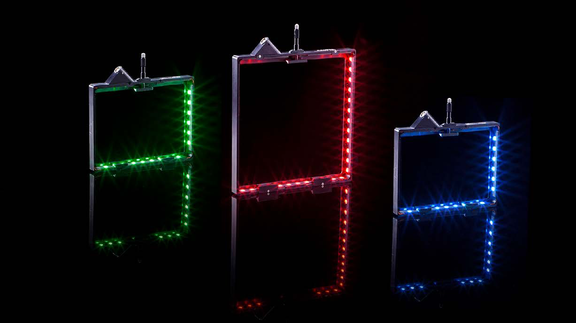
We are actually working on a second series of this set now where we’ve take some of our modifications even further. Larger apertures, even closer focus, fun stuff like that.
The Blackwing7 Binaries on The Prom were the first two sets: 001 and 002. They are modern lenses engineered with that vintage look in mind. They have a beautiful falloff to them with a very interesting reaction to light. The Blackwing7s Matty used on The Prom are the original Binary tuning. These Binary lenses produce a strong internal barrel flare which gives a fun rainbow effect on screen that you see a number of times in the film.
Matty also used Leitz Primes lenses on The Prom, saying, “I want clean and contrasty on this one.” This is the opposite of what he usually does; he usually wants to break it down and deconstruct the scenes. Clean and contrasty is why we quickly suggested the Leitz Primes. Of course, it’s Matty, so you always want to give him something special. They were brand new. Some focal lengths were not even in serial production. Rainer Hercher at Leitz was very committed to getting them in our hands quickly enough for Matty to use on The Prom. Some of the focal lengths were loaners and pre-production models from Leitz, some of them were ours, and then as we started getting our own, we wanted Matty to use them all.
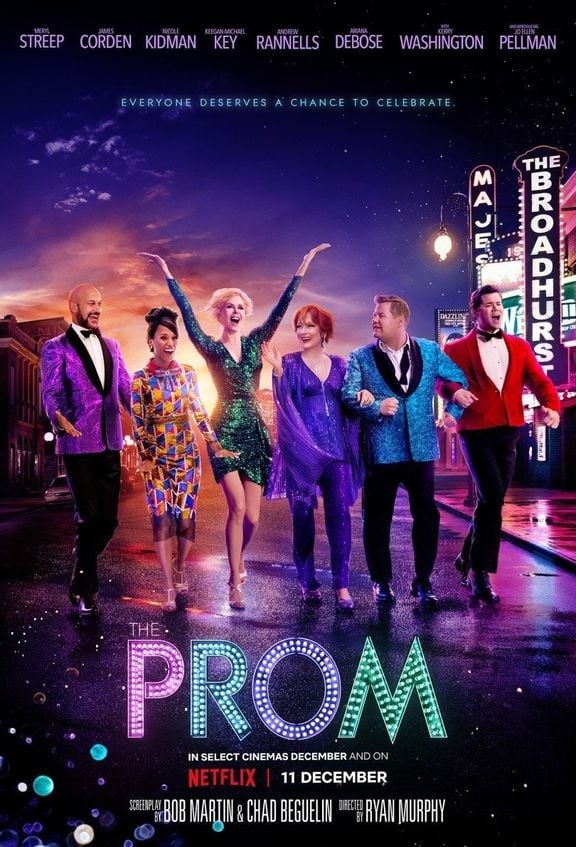
Shot with Leitz
The Prom
2020 | movieA troupe of hilariously self-obsessed theater stars swarm into a small conservative Indiana town in support of a high school girl who wants to take her girlfriend to the prom.
